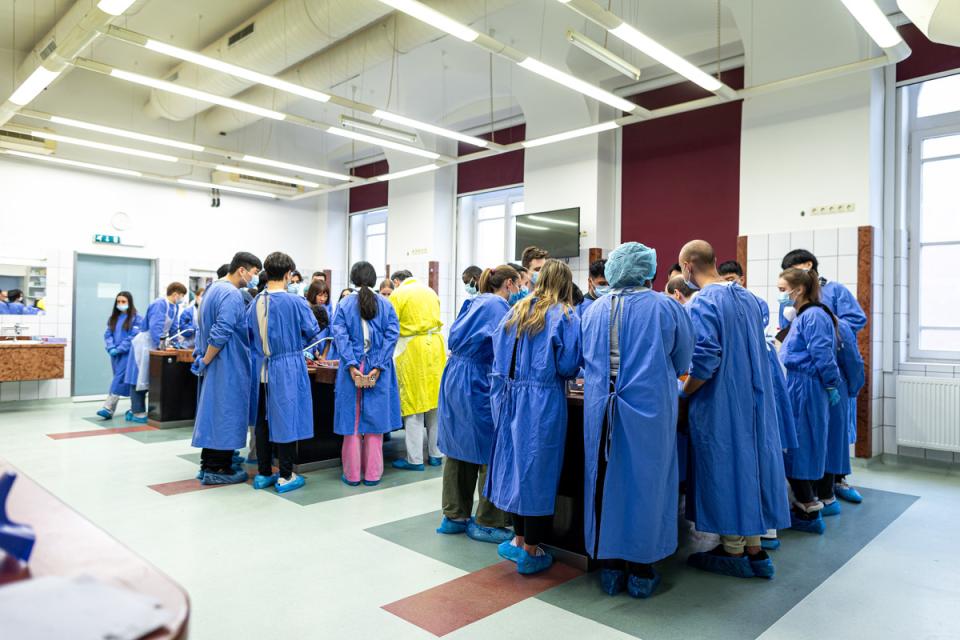
How practical education and talent management support medical students
In the pursuit of academic excellence, our university sets its faculty a triple mission: teaching, science and patient care. And these must go hand in hand. Thus, experienced medical colleagues with continuous daily practice teach future doctors, nurses, physiotherapists and other healthcare professionals. These instructors are typically active researchers and successful specialists in their field, ensuring that students gain an early insight into the beauty and necessity of medical research.
This triple mission is not, however, composed of three coordinated elements: high-quality education and research must benefit, and are subordinated to, effective patient care. As the largest healthcare provider in Hungary, Semmelweis University ensures that students can be continuously involved in the care of patients in its clinics during their undergraduate years.
Hands-on education programmes: proximity to patients and job shadowing
Practice-oriented learning allows students to interact directly with patients and medical equipment. In this way, future physicians can develop clinical skills, bedside manner and the ability to make real-time decisions in a controlled environment. Engaging in practice-oriented education immerses students in the medical environment, familiarising them with the dynamics of healthcare settings, interdisciplinary collaboration and the challenges of patient-centred care.
- Why medical teaching resources need to represent all skin colours
- Challenging elitism in medicine
- Messy decisions and creative science in the classroom
While virtual-reality equipment can simulate scenarios and procedures, as a supplement to medical training, it may not fully replicate the complexity and unpredictability of real patient interactions. Practice-oriented education gives aspiring physicians opportunities to hone their clinical judgement, communication skills and physical-examination techniques.
At Semmelweis University, knowledge is acquired through experimentation or direct personal contact with patients in all subjects, including preclinical and clinical courses. Anatomy, for example, is taught in the dissection room where students have to dissect and identify structures on the body themselves.

Broad, solidly grounded preclinical education based on experimental evidence and personal experience paves the way for clinical education. For this reason, we have restructured our curriculum so that all preclinical knowledge must be acquired before starting clinical blocks. This enables students to learn in a pure block system; they are required to live in the department or hospital of their selected discipline for weeks, where they can focus on and follow the diagnosis and therapy of patients and shadow their tutor physician.
Individualised talent management and students’ associations
The best ideas usually come from students. Their still-naive and ambitious mindsets, unconstrained by academic routine, are the driving force behind new discoveries. In both the preclinical and clinical years, students form small groups where two-way personal communication with the teacher and teamwork among students is maintained. Also, one of our major strengths is the one-to-one contact with students. Our students are welcome to join the laboratories of all departments of the university to broaden their scientific interests and launch their academic careers.
Our most talented students are hosted by the Students’ Scientific Association. Students in the German- and English-language programmes have their own students’ associations. Students’ associations require their members to carry out their own research projects and present a summary of their results at annual competition congresses. More than 100 out of the 500 presentations have been delivered by international students at these conferences in recent years.
In fact, more than a third of our 15,000 students enrolled today are international. The number of applicants to the German- and English-language programmes at Semmelweis University has been growing since its international programme was launched 40 years ago. In the past five years, the number of international students has expanded by 46 per cent, with the medical faculty receiving nearly twice as many non-Hungarian first-year students as Hungarian ones.
Undergraduate scientific activity opens the door for our postgraduate scientific programmes; our doctoral school is welcoming more international students in all disciplines eligible for public scholarships. Yet, our talent support programme goes beyond scientific tutoring; our mentoring programme supports the top 1 per cent of students, even those who do not want to become researchers. In this programme, students are assigned a personal mentor from among the top academic staff. This opportunity provides personal, targeted support to our most talented future young colleagues to get their careers off the ground.
Alán Alpár is the vice-rector for international education and director and full professor in the department of anatomy, histology and embryology at Semmelweis University, Budapest.
If you would like advice and insight from academics and university staff delivered direct to your inbox each week, sign up for the Campus newsletter.




